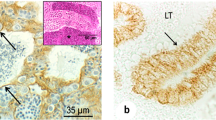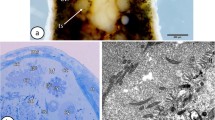Abstract
The testicular capsule and peritubular boundary tissue of the emu and ostrich, as typical representatives of ratite birds, were studied in sexually mature and active birds. The testicular capsule was much thicker (578.1±73.4 μm for the free surface of the ostrich testis, and 176.2±57.5 μm for the emu) than those of members of the Galloanserae. The cellular composition of both testicular capsule and peritubular tissue was similar generally to that of members of the previously studied Galloanserae and of mammals. The tunica albuginea of the testicular capsule mainly comprised smooth-muscle-like or myoid cells mostly running in one direction and occurring in one main mass. Unlike the Galloanserae, the tunica albuginea contained more collagen fibres than smooth muscle cells, especially in the ostrich. Peritubular tissue was similarly composed of smooth-muscle-like cells distributed in several layers. Actin microfilaments and desmin and vimentin intermediate filaments were variably immunoexpressed in these two tissue types in both birds, with a clear dichotomy in the peritubular tissue. Thus, taken together with studies of some members of the Galloanserae, avian testes clearly contain a morphological mechanism that is represented partly by the smooth muscle cells of the testicular capsule and peritubular tissue for transporting the testicular fluid, which is usually copious in birds, and its cellular content from the testis into the excurrent duct system; this mechanism is similar to that found in mammals.





Similar content being viewed by others

References
Aire TA (1997) The structure of the interstitial tissue of the active and resting avian testis. Onderstepoort J Vet Res 64:291–299
Aire TA (2007a) Anatomy of the testis and male reproductive tract. In: Jamieson BGM (ed) Reproductive biology and phylogeny of birds. Science Publishers, N.H., USA, pp 37–113
Aire TA (2007b) Spermatogenesis and testicular cycles. In: Jamieson BGM (ed) Reproductive biology and phylogeny of birds. Science Publishers, N.H., USA, pp 279–347
Aire TA, Ozegbe PC (2007) The testicular capsule and the peritubular tissue of birds: morphometry, histology, ultrastructure and immunohistochemistry. J Anat 210:31–40
Arenas MI, Bethencourt FR, Fraile B, Paniagua R (1997) Immunocytochemical and quantitative study of the tunica albuginea testis in young and ageing men. Histochem Cell Biol 107:469–477
Banks FCL, Knight GE, Calvert RC, Turmaine M, Thompson CS, Mikhalidis DP, Morgan RJ, Burnstock G (2006) Smooth muscle and purinergic contraction of the human, rabbit, rat, and mouse testicular capsule. Biol Reprod 74:473–480
Bustos-Obregon E, Courot M (1974) Ultrastructure of the lamina propria in the ovine seminiferous tubule. Development and some endocrine considerations. Cell Tissue Res 150:481–492
Davis JR, Langford GA, Kirby PJ (1970) The testicular capsule. In: Johnson AD, Gomes R, Vandemark NL (eds) The testis. Development, anatomy and physiology, vol 1. Academic Press, London, pp 281–337
Georgatos SD (1993) Dynamics of intermediate filaments. Recent progress and unanswered questions. FEBS Lett 318:101–107
Hargrove JL, MacIndoe JH, Ellis LC (1977) Testicular contractile cells and sperm transport. Fertil Steril 28:146–1157
Hodges RD (1974) The histology of the fowl. Academic Press, London
Holstein AF (1967) Muskulatur und Motilität des Nebenhodens beim Kaninchen. Z Zellforsch 76:498–510
Holstein AF, Weiss C (1967) Ûber die Wirkung der glatten Muskulatur in der Tunica albuginea in Hoden des Kaninchens; Messungen des intersitiellen Druckes. Z Ges Exp Med 142:334–337
Lake PE (1971) The male in reproduction. In: Bell DJ, Freeman BM (eds) Physiology and biochemistry of the domestic fowl, vol 3. Academic Press, London, pp 1411–1447
Langford GA, Heller CG (1973) Fine structure of muscle cells of the human testicular capsule: basis of testicular contractions. Science 79:573–575
Leeson TS, Cookson FB (1974) The mammalian testicular capsule and its muscle elements. J Morphol 144:237–254
Leeson CR, Forman DE (1981) Postnatal development and differentiation of contractile cells within the rabbit testis. J Anat 132:491–511
Maekawa M, Nagano T, Kamimura T, Ishikawa H, Dezawa M (1991) Distribution of actin-filament bundles in myoid cells, Sertoli cells, and tunica albuginea of rat and mouse testes. Cell Tissue Res 266:295–300
Maekawa M, Kamimura K, Nagano T (1996) Peritubular myoid cells in the testis: their structure and function. Arch Histol Cytol 59:1–13
Maretta M, Marettova E (2004) Immunohistochemical demonstration of myoid cells in the testis and its excurrent ducts in the domestic fowl. Br Poult Sci 45:585–589
Middendorff R, Müller D, Mewe M, Mukhopadhyay AK, Holstein AF, Davidoff MS (2002) The tunica albuginea of the human testis is characterized by complex contraction and relaxation activities regulated by cyclic GMP. J Clin Endocrinol Metab 87:3486–3499
Paranko J, Pelliniemi LJ (1992) Differentiation of smooth muscle cells in the fetal rat testis and ovary: localization of alkaline phosphatase, smooth muscle myosin, F-actin, desmin. Cell Tissue Res 268:521–530
Rothwell B, Tingari MD (1973) The ultrastructure of the boundary tissue of the seminiferous tubule in the testis of the domestic fowl (Gallus domesticus). J Anat 114:321–328
Santamaria L, Reoyo A, Regadera J, Paniagua R (1990) Histochemistry and ultrastructure of nerve fibres and contractile cells in the tunica albuginea of the rat testis. Acta Anat 139:126–133
Schlatt S, Weinbauer GF, Arslan M, Nieschlag E (1993) Appearance of α-smooth muscle actin in peritubular cells of monkey testes is induced by androgens, modulated by follicle-stimulating hormone, and maintained after hormonal withdrawal. J Androl 14:340–350
Steger K, Wrobel K-H (1994) Immunohistochemical demonstration of cytoskeletal proteins in the ovine testis during postnatal development. Anat Embryol 189:521–530
Van Nassauw L, Harrisson F, Callebaut M (1993) Smooth muscle cell in the peritubular tissue of the quail. Eur J Morphol 31:60–64
Virtanen I, Kalljoki M, Närvänen O, Paranko J, Thornell L-E, Miettinen M, Lehto V-P (1986) Peritubular myoid cells of human and rat testis are smooth muscle cells that contain desmin-type intermediate filaments. Anat Rec 215:10–20
Wrobel K-H, Mademann R, Sinowatz F (1979) The lamina propria of the bovine seminiferous tubule. Cell Tissue Res 202:357–377
Wrobel K-H, Dostal S, Schimmer M (1988) Postnatal development of the tubular lamina propria and the intertubular tissue in the bovine testis. Cell Tissue Res 252:639–653
Wrobel K-H, Bickel D, Kujat R (1995) Distribution pattern of F-actin, vimentin and alpha-tubulin in the bovine testis during postnatal development. Acta Anat 253:263–272
Author information
Authors and Affiliations
Corresponding author
Additional information
The authors are grateful for a University of Pretoria research grant, which aided this work. Dr Peter Ozegbe of the Department of Veterinary Anatomy, University of Ibadan is a recipient of the University of Pretoria Foreign Post-Doctoral Fellowship.
Rights and permissions
About this article
Cite this article
Ozegbe, P.C., Aire, T.A., Madekurozwa, MC. et al. Morphological and immunohistochemical study of testicular capsule and peritubular tissue of emu (Dromaius novaehollandiae) and ostrich (Struthio camelus). Cell Tissue Res 332, 151–158 (2008). https://doi.org/10.1007/s00441-007-0515-2
Received:
Accepted:
Published:
Issue Date:
DOI: https://doi.org/10.1007/s00441-007-0515-2



